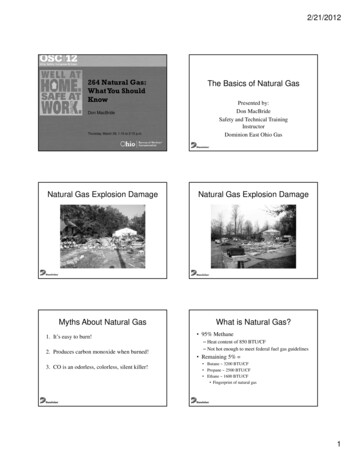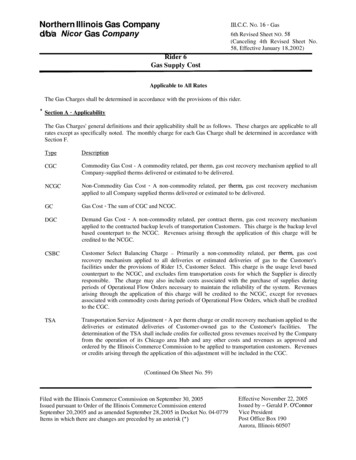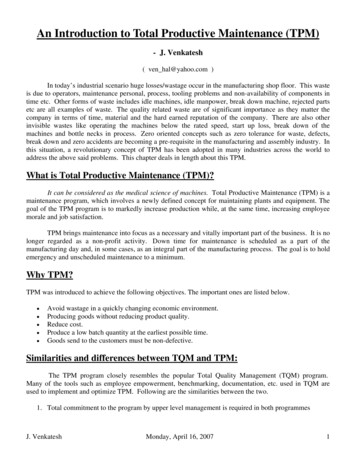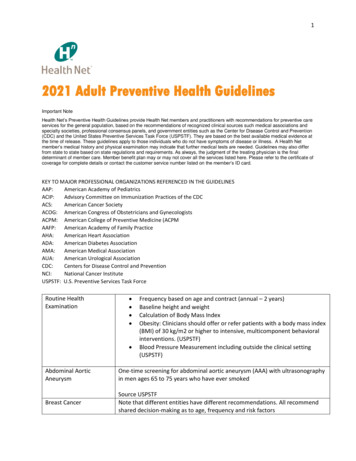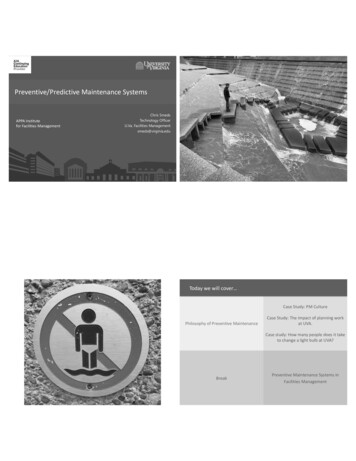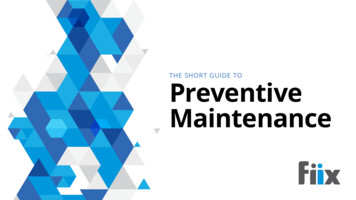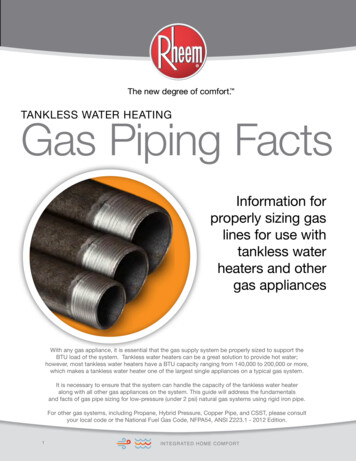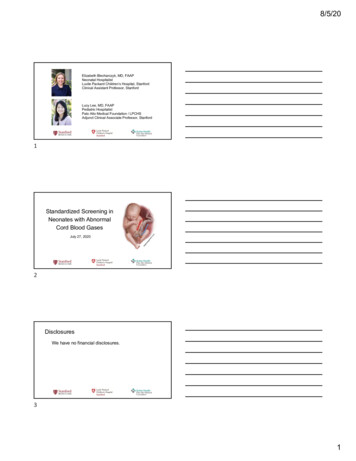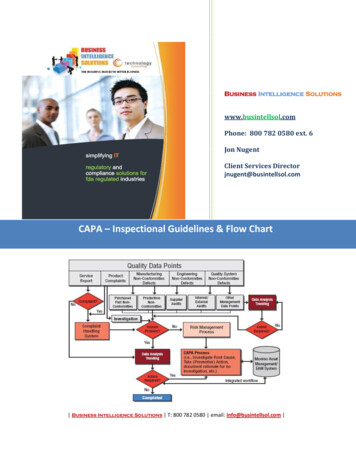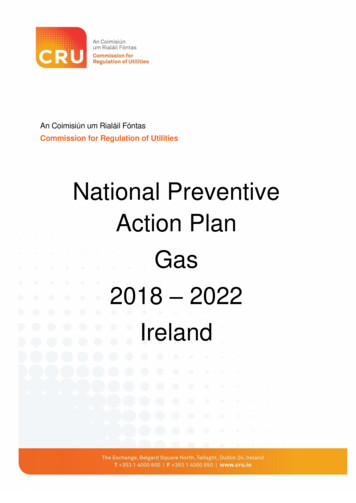
Transcription
An Coimisiún um Rialáil FóntasCommission for Regulation of UtilitiesNational PreventiveAction PlanGas2018 – 2022Ireland
Table of ContentsGlossary of Terms and Abbreviations . ivRelated Documents . vExecutive Summary . 1Public/Customer Impact Statement . 412Introduction . 51.1Competent Authority . 51.2Risk Groups . 51.3Development of the Preventative Action Plan . 5Description of the System . 72.12.1.1UK Risk Group . 72.1.2Norway Risk Group . 72.23Description of the system (National level) . 82.2.1Market Structure . 82.2.2Gas Network . 102.2.3Technical Capacity of Gas Transmission Network . 132.2.4Network Operations. 142.2.5Gas Demand . 162.2.6Gas Supply . 242.2.7PointGas Transportation Arrangements & Gas Flows at Entry/Exit. 242.2.8Gas & Electricity Interactions . 27Summary of the Risk Assessments . 293.1Regional Risk Assessments . 293.1.1UK Risk Group . 293.1.2Scenario example. 303.24Description of the system (Regional gas system for each risk group) 7National Risk Assessment . 303.2.1Internal Systems Hazards . 303.2.2Cyber Security . 323.2.3External Hazards . 323.2.4Disruption of Imports from GB and Outside of EU . 33Infrastructure Standard (Article 5) . 35
4.1564.1.1N-1 Calculations . 364.1.2Bi-directional capacity . 37Supply Standard . 405.1Ireland’s Compliance with the Supply Standard . 435.2Economic Impact of Gas Supply Interruptions . 45Preventative Measures. 476.17N-1 Formula . 35Market-based Supply Side . 476.1.1Market-based Supply Side Measures. 476.1.2Market-based Demand Side . 486.2Non-Market-based Measures . 496.3Infrastructure Projects & Operational Improvements . 516.4Impact of Preventative Measures . 52Obligations on Relevant Bodies . 537.1Natural Gas Undertaking (NGU) . 537.1.1Obligations on Gas Shippers and Gas Suppliers . 537.1.2Obligations on Transmission System Operator (GNI) . 537.1.3Obligations on Gas Producers . 547.1.4Obligations on Gas Storage Operators . 547.1.5Exception to Obligation on NGUs . 547.1.6Safety Obligation on NGUs . 547.2Other Relevant Bodies . 557.2.1 Department of Communications, Climate Action, and theEnvironment (DCCAE) . 558Regional Approach . 569Summary . 58
Glossary of Terms and AbbreviationsAbbreviation or inition or MeaningCommission for Regulation of UtilitiesDepartment of Communications, Climate Actionand EnvironmentDepartment of Business Energy and IndustrialStrategyDepartment for the EconomyDistribution Control SystemEuropean UnionEuropean Network of Transmission SystemOperators for GasGreat BritainGas Co-ordination GroupGas Electricity Emergency PlanningGas Networks IrelandInterconnectorJoint Preventive Action PlanLiquefied Natural GasNational Balancing PointNetwork Development PlanNational Gas Emergency MangerNatural Gas Emergency PlanNorthern IrelandNatural Gas UndertakingNational Regulatory AuthorityNational Transmission SystemPreventive Action PlanProject of Common InterestStatutory InstrumentSouth North PipelineSouth West Scotland Onshore SystemTransmission System OperatorUnited Kingdom
Related Documentsi.Ireland’s 2018 National Risk Assessment;ii.Regulation (EU) 2017 / 1938 concerning measures to safeguard thesecurity of gas supply;iii.Ireland's 2016 National Preventive Action Plan - Gas (CER/16/340);iv.Ireland's 2016 National Gas Supply Emergency Plan (CER/16/338);v.Norway Risk Group Assessment 2018; andvi.United Kingdom Risk Group Assessment 2018.
Executive SummaryThis CRU document has been developed in line with the previous NationalPreventive Action Plan, existing European Regulation’s, and bi-lateralarrangements. This document has not been developed to consider the potentialimplications of Brexit on the Irish Gas System.The Security of Gas Supply RegulationEU Regulation 2017/1938 (“The Regulation”) mandates that EU Member Statesare required to implement measures to safeguard gas security of supply. Toassess Member State’s ability to supply gas, under predefined Standards (i.e.Infrastructure Standard and Gas Supply Standard), Regulation 2017/1938requires each Member State to prepare a National Risk Assessment. TheNational Risk Assessment identifies possible risks and hazards to MemberStates security of gas supply. In addition, Member States are required toprepare a Preventive Action Plan which outlines measures to either remove ormitigate the risks and hazards identified in the Risk Assessment.Preventive Action PlanPursuant to EU Regulation 2017/1938 (“the Regulation”), Member States arerequired to implement measures to safeguard security of gas supply including,inter-alia, the development of a Preventive Action Plan.There is a requirement to update the action plan every four years. In fulfilmentof this requirement, the CRU has prepared this document, which is thePreventative Action Plan for 2018 – 2022.The primary tenet of the Preventive Action Plan is risk management, as theRegulation requires that Member States develop preventive measures, toreduce the risk to gas supplies, and to safeguard supplies to protectedcustomers. Consequently, the preventive measures identified within thisPreventive Action Plan for 2018 to 2022, are in response to the risks identifiedwithin Ireland’s latest Risk Assessment document. The latest Risk Assessmentwas submitted to the European Commission in October 2018.Ireland’s Risk AssessmentThe Infrastructure Standard: is assessed by performing the N-1 calculation.The N-1 calculation removes the technical capacity of the single largest pieceof gas infrastructure on a peak day with a view to determining whether theremaining gas infrastructure can meet 100% of peak day gas demand. To pass,the calculation must equate to 100% or more. Ireland failed the InfrastructureStandard meaning that after losing the single largest gas infrastructure thetechnical capacity of the remaining infrastructure cannot meet demand. To pass1
the Infrastructure Standard, Ireland requested the United Kingdom (UK) toadopt a regional approach, which takes the island of Ireland and Great Britainas one region for the assessment. Further details on the regional approach canbe found in the UK’s Regional Risk Assessment.The Gas Supply Standard: is based on ensuring gas supply to protectedcustomers and Ireland currently meets this requirement on a national basis. Toensure gas supply to protected customers (e.g. residential customer, small tomedium enterprises and special categories such as hospitals etc.), the followingobligations have been placed on Natural Gas Undertakings: the gas transmission system operator to build network for a 1-in-50 winter; suppliers to book capacity for protected customers for a 1-in-50 winter,and; gas producers and storage operators to comply with instructions of theNational Gas Emergency Manager (NGEM) in an emergency, which mayinclude injecting into the system during an emergency.Ireland complies with the Supply Standard and can ensure gas supply toprotected customers. An examination of internal system hazards reveal that gassupplies to protected customers would only be jeopardised in the event of amixed failure event (e.g. loss of Beattock compressor station and CappaghSouth AGI and Kinsale production).Loss of Gas Supply from Great Britain (GB): during 2016 the energyregulator for Great Britain (Ofgem) sharpened incentives on gas shippers toenhance security of supply in Britain. Shippers in Britain who are short during agas deficit emergency would be required to compensate firm customers whoseload is interrupted. As a result, GB shippers will have greater financialincentives to ensure continuation of gas supplies in GB. These incentives in GBcould have a positive impact for the Irish gas market. However, there could bea negative impact depending on commercial incentives in Ireland, and thebehaviour of shippers in response to those incentives.Loss of Gas Supply Outside of EU: An EU Commission analysis in 2009indicated that a disruption of gas supplies from a country outside the EU doesnot pose any significant risk to gas supplies to the UK or Ireland. The likelyimpact on Ireland could be an increase in wholesale gas prices.Furthermore, ENTSOG was required under Article 7 of Regulation (EU) 1938 /2017 to carry out a Union-wide simulation of gas supply and infrastructuredisruption scenarios.1 As part of this analysis Ireland was assessed as part ion%20report INV0262-171121.pdf2
the North Sea Gas supply group across a number of regional disruptionscenarios. The analysis showed that there was no impact on Ireland in any ofthe relevant risk scenarios.Potential Risks and Hazards: Ireland’s Risk Assessment considered failuremodes at entry points and various system components (e.g. above groundinstallations). External hazards, such as natural and manmade hazards werealso considered. The Preventive Action Plan, through preventive measures,aims to eliminate, or reduce the impact of these risks on gas customers inIreland.Preventive MeasuresMarket-based measures rely on supply and demand dynamics, in particulargiven Ireland’s connection to the highly liquid National Balancing Point (NBP)in Great Britain. In a gas supply shortage, the wholesale market should react,and a rise in wholesale prices should reduce demand. Non-market-basedmeasures are to be used when market-based measures alone cannot ensuregas supplies to protected customers.Market-based Supply Side Measures in Ireland: Ireland has indigenousproduction capacity at the Corrib gas field and some limited production capacityin the depleting Kinsale gas field.Measures such as reverse flow, coordinated dispatching, long term contracts,and short-term contracts have no additional benefits to gas security of supplyin Ireland. The market signals from the UK’s NBP should result in pricing signalsresulting in industrial customers opting not to consume gas (i.e. reducingdemand).Market-based Demand Side Measures in Ireland: The majority of gasdemand in Ireland can be attributed to power generation consumption, whichaveraged 58% of annual gas demand in 2016/17. Due to operational limitationson the electricity system, it is too risky to have an uncontrolled fuel switch fromgas fired generators to secondary fuel (i.e. oil). As such, a controlled fuel switchover a more prolonged period may occur.Non-Market-based Supply Side Measures in Ireland: measures includingincreased indigenous production is provided for in Ireland’s NationalEmergency Plan. In 2018, the Corrib gas field is expected to meet up to 64% ofIreland’s annual system demand, with the Inch and Moffat Entry Pointsproviding the remaining 7% and 29%, respectively. By 2020/21 Corrib gassupplies are expected to account for around 44% of gas demand in Ireland, withInch expected to cease production in 2020.Market-based Supply Demand Measures in Ireland: Fuel switching is a nonmarket-based measure that could be used to ensure gas security of supply.3
The electricity TSO (EirGrid) has indicated that there are electricity networkoperational limitations e.g. risk of tripping that require a controlled switch overto secondary fuel EirGrid have indicated that the electricity system wouldrequire 30 hours to switch the 12 gas fired plants (12 gas fired plants would beexpected to be operating on a peak gas day) to their secondary fuel. Thisramping down would require gas consumption equivalent to 60% of the overallpeak day gas demand. In addition, daily metered customer’s e.g. industrialusers could also provide demand side response to a potential emergency.Public/Customer Impact StatementThere are approximately 687,000 natural gas customers in Ireland, whocontribute to the operation of the gas network through their gas bills. In theevent of a gas shortage, Ireland’s Preventive Action Plan endeavours to ensuregas continues to flow to Protected Customers. Protected Customers in Irelandare defined in the table below:Ireland’s Definition of Protected CustomerAll NDM sector customers (residential and some small business) and, inaddition, priority customers in the DM sector which are of the followingcategories: Hospitals and Nursing Homes including retirement homes; High Security Prisons; and District Heating Schemes and further categories of essential socialservices as determined by the CRU from time to time.4
1 Introduction1.1 Competent AuthorityThe Commission for Regulation of Utilities (CRU) is the competent authorityunder Regulation 2017/1938. The primary obligations of the CRU asdesignated Competent Authority under the Regulation include: the completion of a Risk Assessment, the establishment of a Preventive Action Plan and Emergency Plan 2 inorder to mitigate the risks identified in the Risk Assessment, the monitoring of security of gas supply at national level, cooperating with other Competent Authorities to prevent a supplydisruption and to limit damages in such an event; and establishing the roles and responsibilities of relevant market participants .In addition to the security of supply functions, the CRU also has explicit safetyfunctions relating to the safe storage, transmission, distribution and utilisationof natural gas.1.2 Risk GroupsIreland is a member of the UK Risk Group and the Norway Risk Group. Themembers are as follows:-UK Risk Group: UK, Belgium, Germany, Ireland, Luxembourg and theNetherlandsNorway Risk Group: UK, Belgium, Denmark, Germany, Ireland, Spain,France, Italy, Luxembourg, the Netherlands, Portugal, and Sweden1.3 Development of the Preventative Action PlanThe Preventative Action Plan for 2018 – 2022 has been prepared in accordancewith Article 8 and 9 of Regulation 2017/1938. Article 8 relates to theestablishment of an action plan, while Article 9 sets out the required content ofthe plan. In compliance with Article 9, the Preventive Action Plan 2018 – 2022includes: the results of Ireland’s national Risk Assessment, the measures, volumes, capacities and the timing needed to fulfil theinfrastructure and supply standards,5
the obligations on Natural Gas Undertakings (NGUs) and other relevantbodies, other preventive measures to address the risks identified in order tomaintain gas supply (where possible) to all customers, the mechanisms to be used for cooperation with other Member States forpreparing and implementing joint Preventive Action Plans, information on existing and future interconnections, and; information on Public Service Obligations (PSOs) regarding security ofgas supply.In terms of preparing Ireland’s Preventive Action Plan, cognisance was givento the Regulation’s requirements that the Preventative Action Plan take accountof 10-year network development plan for Europe, as developed by theEuropean Network of Transmission System Operators for Gas (ENTSOG), andthe emphasis attached to the utilisation of market-based security of gas supplymeasures.6
2 Description of the SystemThe objective of this section is to provide an overview of the Irish gas market.In particular, this section focuses on the structure of the Irish gas market, thegas network, and the supply and demand for gas, thus providing thefoundations for interpreting Ireland’s Risk Assessment. Ireland is part of the UKRisk Group and the Norway Risk Group.2.1 Description of the system (Regional gas systemfor each risk group)2.1.1 UK Risk GroupThe natural gas systems of the members of the United Kingdom Risk Groupare characterised by significant levels of interconnection, liquid markets andsufficient infrastructure that more than meets the region’s needs. The UnitedKingdom Risk Group is comprised of the natural gas systems of the UKBelgium, Germany, Ireland, Luxembourg and the Netherlands.With the exception of Belgium and Luxembourg, all Member States of theUnited Kingdom Risk Group have some level of domestic production,underpinning the resilience of the north-west European gas system. The UnitedKingdom and the Netherlands are the two largest natural gas producers in theEuropean Union, producing approximately 416TWh (38 bcm) and 430TWh (44bcm) respectively in 2017.Although production from the United Kingdom Continental Shelf (UKCS) has,since 2014, increased year-on-year due to the development of new fields andincreased production at some of the existing fields, production from the UKCShas generally been falling since the turn of the century, with production decliningby around 8% a year between 2000 and 2013. Production is forecast to returnto a pattern of decline.Natural gas production in the Netherlands will decline rapidly over the nextdecade, due to the decision taken in 2018 to terminate production from theGroningen gas field by 2030. The shutdown in Groningen production isexpected to reduce national Dutch production by an average of 19% per yearin the period 2018-2021.2.1.2 Norway Risk GroupNorway is a major oil and gas producer and, since 2012, natural gas is thelargest energy source produced in the country. In 2015, it accounted for half ofthe total energy produced in Norway. Total gas production reached a record in2017 with 124 bcm. After growing steadily from the mid-1990s, natural gasproduction has stabilized in recent years at a high level. All the natural gas isproduced from combined oil and gas extraction.7
The Norwegian Petroleum Directorate’s (NPD) production forecast currentlyforesees a relatively stable for the next few years and a decrease from the early2020s. Production from new fields that come on stream will partly compensatefor the decline in production from some ageing fields. In the longer term, thelevel of production will depend on new discoveries being made, thedevelopment of discoveries, and the implementation of improved recoveryprojects on existing fields. Gas supplies from Norway are therefore notexpected to contribute beyond what has been delivered so far.In Norway only 5% of the produced gas is consumed in the country. The vastmajority of the gas is exported, mainly to neighbouring consuming countries inthe North Sea area. Most of the gas is exported via subsea pipelines todestinations in Western Europe. Germany is the main importer, accounting for42% of Norwegian gas exports in 2015, followed by the United Kingdom (25%),France (15%), and Belgium (12%). Exports from Norway cover more than 20%of the European gas demand and are a major contributor to the European gassupply security.2.2 Description of the system (National level)2.2.1 Market StructurePrior to market liberalisation, the Irish gas market was controlled by stateowned company Bord Gáis Éireann (BGÉ), which operated as a monopoly.Under the 1976 Gas Act, BGÉ was given sole responsibility for the purchasing,transmission, distribution and supply of natural gas in Ireland, and thereforeoperated as a Vertically Integrated Utility (VIU) company.Following the EU’s decision in 1988 to create an internal energy market, thestructure of the Irish gas market has gradually evolved in accordance with theprovisions contained within the EU energy packages. Consequently, by 2007all Irish gas consumers were permitted to choose alternative gas suppliers, andgas shippers were granted third party access to BGÉ’s gas transmission anddistribution system.In order to facilitate third party access to the gas network, Gaslink (anindependent subsidiary of BGÉ) was established in 2008 as an IndependentSystem Operator (ISO). Specifically, Gaslink had responsibility for theoperation, maintenance and development of the gas transmission anddistribution system, while BGÉ remained as owner of the gas transmission anddistribution system.33BGÉ through its division Bord Gais Networks (BGN) continued to carry out work and provided servicesat the direction of Gaslink in respect of the development, maintenance and operation of BGÉ’s network.8
With reference to market size, there are over 687,000 natural gas customers inIreland, who can obtain gas supply from various gas suppliers.4 In relation tocustomer classification, Irish gas customers are categorised into the followingdemand categories: Large Daily Metered (LDM);5Daily Metered (DM),6 and;Non-Daily Metered (NDM).7In 2012, the Irish Government announced its intention to sell BGÉ’s nonnetworks energy business (“Bord Gáis Energy”), as part of the State assetdisposal programme. In 2013, the Irish government confirmed that a preferredbidder was selected for the sale of Bord Gáis Energy. In order to facilitate thesale of Bord Gáis Energy, the Irish Government introduced the Gas RegulationAct 2013, which provided the legislative framework for the legal separation andsale of BGÉ’s energy business and the re-organisation of the networksbusiness into a single entity.During a period of significant company restructuring within BGÉ, the followingevents occurred: July 2013: Following an Irish Government decision, BGÉ wasdesignated with responsibility for the provision of water and waste waterservices in Ireland, which resulted in the establishment of Irish Water asa subsidiary within the BGÉ Group.June 2014: In accordance with Section 8(1) of the ESB (ElectronicCommunications Networks) Act 2014, the Irish Minister forCommunication, Energy and Natural Resources (MCENR) renamedBGÉ as Ervia.June 2014: Bord Gáis Energy sale was completed.December 2014: Bord Gáis Networks (BGN) business rebranded asGas Networks Ireland (GNI).January 2015: GNI was incorporated as a wholly owned subsidiary ofErvia.April 2015: BGÉ (UK) changed its name to GNI (UK) Ltd.4Appendix 1 provides a list of gas suppliers operating in the Irish gas market, and a list of Irish gasshippers who are registered at Ireland’s gas entry points (i.e. Moffat, Inch and Corrib).5LDM sites are sites with an annual demand of 57 GWh or greater, and includes all gas fired powerstations and large industrial/commercial sites. There is approximately 37 LDM industrial/commercialcustomers connected at transmission level and 15 on the distribution network.6DM sites are sites with an annual demand greater than 5.55 GWh and less than 57 GWh (e.g. mediumindustrial/commercial customers, hospitals). There is approximately 17 industrial/commercial customerson the transmission network and 202 at distribution level.7NDM sites are sites with an annual demand of 5.55 GWh or less (e.g. small industrial/commercialcustomers, and residential customers. There is approximately 645,269 residential gas customers inIreland and 25,304 NDM industrial commercial customers.9
August 2015: To complete the company restructuring, as part of theirNetwork Transfer Plan, Ervia and Gaslink transferred assets, licences,rights, liabilities and staff to GNI.On the 29th January 2016, the CRU received an opinion from the EUCommission regarding its preliminary decision to certify GNI. The EUCommission’s opinion requested that the CRU: Require GNI to notify the CRU if additional generation units of Irish Waterstart exporting electricity to the grid;Specify in its final decision whether Ervia’s non-trading companies areengaged in activities of generation or supply of gas or electricity, and;Assess in its final decision the degree of independence, which theMinister for Environment, Community and Local Government (MECLG)enjoys in the exercise of their function in relation to Ervia and GNI.The CRU’s final certification decision was amended to include an obligation onGNI to notify the CRU if additional generation units of Irish Water start exportingelectricity to the grid. Additionally, the CRU confirmed that Ervia’s non-tradingcompanies are not engaged in the activities of generation or supply of gas orelectricity. Finally, the CRU deemed the MECLG and MCENR both independentand not under common influence of another public entity. Consequently, on the29 March 2016, in accordance with Article 10 of the Directive, Article 3 ofRegulation (EC) 715/2009 and S.I. No. 16 of 2015, the CRU certified GNI asFOU compliant8.2.2.2 Gas NetworkGas supply in Ireland is delivered via a network of approximately 14,172 km ofpipelines. The integrated supply network is sub-divided into 2,427 km of highpressure sub-sea and cross-country transmission pipe, and approximately11,745 km of lower pressure distribution pipe (see Figure 1 for further details).Ireland’s onshore gas system consists of a ring-main system between Dublin,Galway and Limerick, with cross-country pipelines running from the ring-mainsystem to Cork, Limerick, Waterford, Dundalk and numerous regional towns.In terms of obtaining gas supplies, the Irish gas system conveys gas from threeentry points, namely: Moffat (Western Scotland);Inch (Southern Ireland), andBellanaboy (Western Ireland)The Moffat entry point connects the Irish natural gas system to National GridGas’s (NGG) gas system in Great Britain (GB), and allows for the importationFor further details please see CRU’s Final Certification Decision - GNI’s Gas FOU CertificationApplication810
of GB gas to Ireland, via two sub-sea Interconnectors and an onshoretransmission network in Scotland (i.e. South West Scotland Onshore System(SWSOS)). From the connection with the NGG’s system at Moffat, the Scotlandbased onshore system consists of: a compressor station at Beattock, which is connected to Brighouse Bayby two pipelines from Beattock to Cluden; 80km of pipeline including a 50km single pipeline from Cluden toBrighouse Bay, (construction on twinning of the 50km of pipeline is ongoing), and; a compressor station at Brighouse Bay, which compresses the importedgas into the two sub-sea Interconnectors.From Brighouse Bay there are two pipelines connecting Ireland to the GB gasnetwork (i.e. Interconnector 1 (IC1) & Interconnector 2 (IC2). IC1 and IC2 areconnected to the onshore Irish system north of Dublin at Loughshinny andGormanston, respectively.The Inch entry point connects the Kinsale and Seven Heads gas fields and theKinsale storage facility to the onshore network. There is also a compressorstation at Midleton, Co. Cork that compresses the gas from Inch to facilitatetransmission throughout the system. The Kinsale storage facility is operated byPSE Kinsale Energy Limited (KEL) using the depleted Southwest Kinsale gasfield. KEL ceased full storage operations in 2017 and commenced blowdown ofSouthwest Kinsale. Currently production is expected to cease in 2020.The Bellanaboy entry point connects the Corrib gas field to the onshore networkThe Bellanaboy entry point is connected to the onshore ring main via the MayoGalway pipeline, this facilitates the flow of gas from the Corrib Field into GNI’ssyst
not pose any significant risk to gas supplies to the UK or Ireland. The likely impact on Ireland could be an increase in wholesale gas prices. Furthermore, ENTSOG was required under Article 7 of Regulation (EU) 1938 / 2017 to carry out a Union-wide simulation of gas supply and infrastructure


